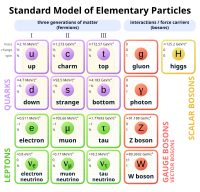
Photo from wikipedia
A bstractThe present upper bound on κe, the ratio between the electron Yukawa coupling and its Standard Model value, is of O600$$ \mathcal{O}(600) $$. We ask what would be the… Click to show full abstract
A bstractThe present upper bound on κe, the ratio between the electron Yukawa coupling and its Standard Model value, is of O600$$ \mathcal{O}(600) $$. We ask what would be the implications in case that κe is close to this upper bound. The simplest extension that allows for such enhancement is that of two Higgs doublet models (2HDM) without natural flavor conservation. In this framework, we find the following consequences: (i) Under certain conditions, measuring κe and κV would be enough to predict values of Yukawa couplings for other fermions and for the H and A scalars. (ii) In the case that the scalar potential has a softly broken Z2 symmetry, the second Higgs doublet must be light, but if there is hard breaking of the symmetry, the second Higgs doublet can be much heavier than the electroweak scale and still allow the electron Yukawa coupling to be very different from its SM value. (iii) CP must not be violated at a level higher than O0.01/κe$$ \mathcal{O}\left(0.01/{\kappa}_e\right) $$ in both the scalar potential and the Yukawa sector. (iv) LHC searches for e+e− resonances constrain this scenario in a significant way. Finally, we study the implications for models where one of the scalar doublets couples only to the first generation, or only to the third generation.
Journal Title: Journal of High Energy Physics
Year Published: 2017
Link to full text (if available)
Share on Social Media: Sign Up to like & get
recommendations!